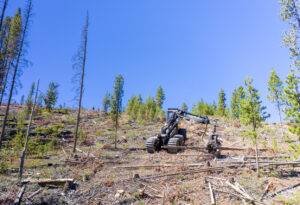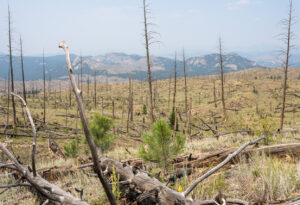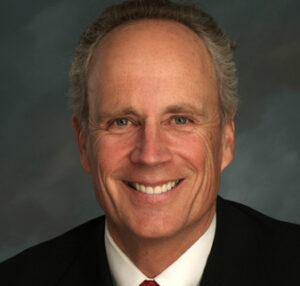Denver Water serves 1.5 million people in the city and county of Denver and the surrounding suburbs. In this interview, Municipal Water Leader Contributing Editor Jeff Kightlinger talks with the utility’s CEO and manager, Jim Lochhead, about its plans to serve its customers in the face of climate change and booming population growth. A project is underway to expand Gross Reservoir to increase the city’s storage capacity. In the future, Mr. Lochhead says, to use less water, Denver Water will need to be proactive and work with agencies that manage wastewater, storm water, and land use.
Jeff Kightlinger: Please tell us about your background. How did your experience as a lawyer prepare you to become the CEO and manager of Denver Water?
Jim Lochhead: I practiced water law in western Colorado, representing counties, municipalities, ditch companies, and developers. I became involved in water policy and was appointed by the governor to the Colorado Water Conservation Board, which in turn led to representing Colorado on interstate Colorado River issues. Governor Romer then appointed me to his cabinet as the executive director of the Colorado Department of Natural Resources. I then returned to law practice and dealt with many large river basin issues. In addition to my Colorado River work, I did work with Mexico, in the Great Lakes, on the Snake River, and on the Pecos River, so I had broad experience with river basin issues generally, and I have an appreciation for the politics involved. The board thought that kind of experience was good for Denver Water.
Jeff Kightlinger: Please introduce Denver Water.

Jim Lochhead: We serve 1.5 million people in the city and county of Denver and the surrounding suburbs. About half our customers are in the city, and half are in the suburbs. We get all our water from the snowpack and precipitation in a 4,000-square-mile watershed area—about half from the Colorado River and half from the South Platte River. It’s a diverse system fed by several watersheds along the Continental Divide. So far, our system has withstood the current drought pretty well.
We’re currently in the biggest capital development program in our history. We completely redeveloped our main campus, a 35‑acre site near downtown Denver, replacing our trade shops, warehouses, fleet, meter shop, and fitness center. Our new administration building is a LEED Platinum, net-zero-energy-certified building that has rainwater capture and an in-building wastewater treatment system for toilet flushing and irrigation. We went through significant regulatory hoops to achieve that, since nobody else has attempted to do this kind of thing in Colorado.
We’re in the process of building a new water treatment plant. We originally based our thinking on the old municipal water planning model, which says that you should build everything twice as big as you need it to be. We reassessed that approach and decided that instead of building a 150-million-gallon-per-day (MGD) plant, we really only needed 75 MGD and could manage the reduced capacity through changes in our distribution system. That cost less and gave us greater flexibility. The plant is modular, allowing us to add additional capacity when needed, which is in line with our new capital investment philosophy of being incremental, modular, adaptable, and flexible. We challenged the engineers to build the plant so that it could be operated off the electric grid. They told us we were crazy, but we said to go ahead and try it anyway. It spurred them to first look for efficiencies in the construction itself and for ways to generate energy through the treatment process. It turns out we will be connected to the grid only so that we can sell power back to the grid as a net energy generator.
At Gross Reservoir, we are raising the height of the existing dam to enlarge the reservoir after a 20‑year permitting process. When completed, it will be the tallest dam in Colorado. The project is designed to correct an imbalance in our system and give us greater resiliency, especially in the face of climate change. The reservoir receives water from western Colorado through a tunnel under the Continental Divide. As part of the permitting process, we worked with some 40 different counties, municipalities, and water districts in western Colorado to develop an agreement to partner on projects and operations that would benefit the aquatic environment on the western slope. It’s a far-reaching peace agreement that secured the support of both western Colorado and key environmental groups for the project.
Jeff Kightlinger: It’s interesting to hear about your modular approach. Most urban areas have seen incredible drops in demand as increases in efficiency have accelerated throughout the urban sector. What’s Denver’s story when it comes to demand and conservation?
Jim Lochhead: We’ve reduced our water use by about 36 percent since 2000. That’s in line with a lot of other municipalities. We are using about as much water as we did in the 1970s, despite the fact that we have about 500,000 more people and 500,000 more jobs in our service area. I anticipate us becoming even more aggressive on conservation throughout our system, particularly given the situation on the Colorado River.

Jeff Kightlinger: We’ve all seen wildfires increase with climate change. Have the fires posed any challenges for Denver Water?
Jim Lochhead: We had wake-up calls in 1996 and 2002 with the Buffalo Creek and Hayman Fires, which at that time were the biggest fires in Colorado’s history. They were in watersheds above a terminal reservoir in our system through which 80 percent of our water supply goes. Those fires were immediately followed by significant rain events, which sent an incredible sediment load into that reservoir. The roughly 1.5 million cubic yards of sediment that are now sitting in the reservoir and moving down toward the dam have not only caused water quality issues but will eventually threaten the integrity of the dam. We can address this, but it will take smart engineering, big thinking, and an enduring commitment.
When I came to Denver Water in 2010, we immediately began working with the federal government to start up a program called From Forests to Faucets. We match U.S. Forest Service (USFS) dollars to carry out forest treatments to prevent catastrophic fire. The idea is to reduce overgrowth, remove trees killed by pine beetles, and allow fire to occur in a more natural and less destructive way. In our key watersheds, we have a model that we use to identify priority areas for treatment. Since 2010, Denver Water has committed $33 million, which was matched by partners to reach a total investment of $66 million, to reduce the risk of high severity fires in priority watersheds.
We had one fire event near Silverthorne, Colorado, a resort community that is near the Summit County ski areas and Dillon Reservoir. The fire occurred right next to two subdivisions where we had undertaken some forest treatment. Firefighters were able to put it out without any damage to the homes and structures in those subdivisions. The USFS went back and did a fire model and concluded that the $1 million investment that we made in forest treatment helped prevent over $1 billion of structural damage.

We also have an extensive watershed health program. We’re working in partnership with local governments, private landowners, the state, and the federal government on overall watershed health, addressing not only forest health, but also abandoned mine issues, septic tank issues, and other challenges that affect water quality and quantity in our watersheds. Given the return on investment, these kinds of front-end investments in natural infrastructure are justifiable and are supported by our customers.
Jeff Kightlinger: It’s always tricky using rate payer money on these kinds of watershed programs, especially on property that is not in your service area or not owned by the utility, but it’s such a good investment. Was it a challenge getting your leadership on board with that approach?
Jim Lochhead: It wasn’t. Our board was supportive from the beginning of the program. We have reupped our funding agreement with the USFS, so the board has remained very supportive of this program. The board members understand the value of natural infrastructure to our ability to serve our customers.
Jeff Kightlinger: Climate change is changing so much of what utilities do in terms of water supply, but it is also affecting fires and other challenges. What do you see as some of the future challenges for Denver Water, besides the obvious ones on the Colorado River?
Jim Lochhead: To your point about the Colorado River, if you look at the climate models on a broad scale, the picture in terms of future water supply is obviously not great. Snowpack doesn’t necessarily translate to river flow, given dry soil conditions, evaporation, and greater demands from the system. On the Colorado Front Range, if you look on a micro level, the climate models are mixed in terms of whether we are going to see more or less precipitation. However, we know that precipitation is going to come in different forms. We’re going to have more rain; less snow; earlier runoff; more rain-on-snow events; and more severe weather events, including both drought and flooding. One of our justifications for enlarging Gross Reservoir is that we need to be able to capture and store rain from those significant events. I don’t anticipate being able to build any significant new projects in the future, including new transmountain diversions. There’s just not the political will because of the environmental impacts. We’re going to have to be more incremental and adaptable and to rely more on efficiency rather than pursuing the traditional municipal utility model of just developing more water supplies.
Like a lot of utilities, we use a scenario-planning approach. We look 50 years in the future under our integrated resource plan. We’re not just looking at population and water supply; we’re looking at everything that affects water demands in our system, including the economy, growth patterns, and social trends related to the extent to which our service area goes green and whether people are living inside or outside the city. All kinds of factors affect how we develop, grow, and meet the demands of our customers. We’re looking at how we can operate under every one of those scenarios.
Jeff Kightlinger: You mentioned recycled water. What kind of reuse does Denver Water have now, and how do you plan to expand that in the future?
Jim Lochhead: We have a recycled treatment plant that we use for irrigation, and we reuse a lot of our water supply by exchange. We capture and store reusable water in reservoirs below our system. Then we release that water to senior water rights holders downstream, which in turn allows us to store water under our junior water rights upstream.
Reuse and recycling is a challenge for us on a couple of fronts. One is that the only water we can reuse is water imported from the Colorado River basin. It creates a kind of dilemma in that if we double down on reuse and recycling in our system, we’re increasing our dependence on Colorado River water, and if there’s a big upset on the system that makes supply unavailable, we’ve just made a huge investment in something that is no longer available.
The other challenge is that we don’t have an ocean to put a brine stream into. We haven’t figured out how to develop a reuse project at scale whose brine stream we can deal with. There might be ways for us in the future to return water to some of our upstream reservoirs simply by pumping it back up.
Jeff Kightlinger: I know that you are a strong believer in using innovation and technology to enhance the utility business. What are some of Denver Water’s current innovations, and what do you hope to see in the future?
Jim Lochhead: We just completed a refresh of our strategic plan. We went through an exercise of trying to look into the future of our position in Colorado and the West. Part of that involves our internal culture. For example, we have an initiative around diversity, equity, and inclusion and are developing an innovative and open culture within the organization. To your point about technology and innovation, there’s a great interest in innovation within our system. We’re working on a comprehensive asset management plan that is going to involve enhanced technology and innovation. We are partnering with Colorado State University on the development of the Hydro Building at the National Western Complex in Denver, a premier rodeo and event venue that is in the process of being completely redeveloped. The Hydro Building will be devoted to water resource policy and research. We are going to build our new water quality lab in that building. We hope to be able to work with private and public sector entities on One Water strategies using various water quality types and understanding treatment techniques and new technologies.
Jeff Kightlinger: What is your vision for Denver Water’s future?
Jim Lochhead: One of the challenges that we have in the West is uncontrolled sprawl. Colorado now has nearly 6 million people. If we grow our next 5 million people the way we did the first 5 million, that’s not going to be sustainable from a water perspective. Denver Water is somewhat fortunate in that our service area is fixed, but we’re going to have to work with our neighbors and the distributors in our service area to increase water efficiency. We are going to have to continue to invest heavily in our watersheds and in the sustainability of our operations. We have aggressive net zero energy goals, and we are going to have to start thinking of net zero water—a way to minimize our water use footprint. That is going to require switching from operating in the role of a traditional water utility to being a lot more proactive and working across agencies—including wastewater, storm water, and land-use agencies—to make sure that we are using water in the most efficient, climate-resilient way.
Jim Lochhead is the CEO and manager of Denver Water. For more on Denver Water, visit www.denverwater.org.

